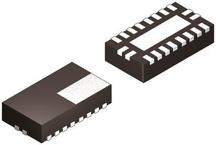herunterladen

1
SLVA520–May 2012
Submit Documentation Feedback
Copyright © 2012, Texas Instruments Incorporated
Creating a Dual USB Universal Car Charger From the TPS40170 and Two
TPS2511
Application Report
SLVA520–May 2012
Creating a Dual USB Universal Car Charger From the
TPS40170 and Two TPS2511
Robert Taylor, Steve Schnier
ABSTRACT
This application report describes how to design a dual USB Universal Car Charger. The design delivers up
to 2.1 A per USB port. The TPS2511 auto-detect feature monitors USB data line voltage, and
automatically provides the correct electrical signatures on the data lines to charge compliant devices
among the following dedicated charging schemes:
• Divider DCP for Apple devices, required to apply 2.7 V/2.0 V or 2.0 V/2.7 V on the D+/D- lines
respectively
• BC1.2 DCP, required to short the D+ line to the D-line
• 1.2 V/1.2 V on the D+/D- lines for Samsung Tablets
The TPS40170 provides the 5-V USB voltage at up to 4.2 A. Due to the small package size and high
efficiency, the TPS40170 is able to deliver full power and still meet thermal constraints for the small form-
factor design. The form factor of the design complies to the UL standard 2089 and ANSI/SAE J563
specification and is easily adapted to meet other form factors.
Contents
1 Universal Car Charger Design Requirements............................................................................ 2
2 Input Protection Circuitry.................................................................................................... 3
3 Switching Power Supply Specifications Using the TPS40170......................................................... 3
3.1 Selecting a Switching Frequency................................................................................. 5
3.2 Output Inductor Selection.......................................................................................... 5
3.3 Output Capacitor Selection........................................................................................ 5
4 Current-limit Switch Specifications Using the TPS2511................................................................ 8
4.1 Selecting the Current-limit Resistor .............................................................................. 8
4.2 DCP Auto-Detect.................................................................................................... 8
5 Experimental Results ...................................................................................................... 10
5.1 Turn-On - (TPS40170: 5V at 0A)................................................................................ 10
5.2 Output Voltage Ripple – (TPS40170: 5 V at 2.1 A (x2)) ..................................................... 11
5.3 Transient Response – (TPS40170: 5 V at 2.1 A (x2))........................................................ 12
5.4 Switching Behavior – (TPS40170: 5 V at 2.1 A (x2))......................................................... 13
5.5 Efficiency – (TPS40170: 5 V at 2.1 A (x2)) .................................................................... 14
5.6 Load Regulation – (TPS40170: 5 V at 2.1 A (x2))............................................................ 14
6 Board Layout................................................................................................................ 15
List of Figures
1 Front and Back of PMP7390 Board....................................................................................... 2
2 USB Car Charger Input Protection Circuit Schematic .................................................................. 4
3 5-V Output TPS2511 Design Example ................................................................................... 8
4 TPS2511 DCP Auto-Detect Functional Diagram ........................................................................ 9
5 Front Thermal-board Image............................................................................................... 10
6 Back Thermal-board Image............................................................................................... 10
7 TPS40170................................................................................................................... 10
Verzeichnis








